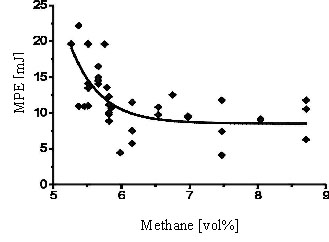-
What are the characteristics of laser ignition?
Date posted:
-
-
Post Author
dev@edge.studio
1. Introduction
[GLOSS]Ignition[/GLOSS] is the process of starting [GLOSS]radical[/GLOSS] reactions until a self-sustaining flame has developed. Ignition was discussed in CF256 and laser ignition discussed in CF268.
2. Characteristics of laser ignition
2.1 Pressure dependence
Figure 1 shows the minimum [GLOSS]laser[/GLOSS] pulse energy [mJ] necessary for the ignition of CH4/air mixtures as a function of initial pressure (the tests were conducted in a constant-volume vessel). The minimum pulse energy (MPE) has to be discerned from the minimum ignition energy (MIE). MPE is always larger than the “true” MIE because not all incident laser light is absorbed by the [GLOSS]plasma[/GLOSS]. Data on minimum ignition energies can be found in [1].

Fig. 1: Minimum laser pulse energy (MPE) in CH4/air mixtures as a function of initial pressure at 340 K and a fuel equivalence ratio F of 0.77. A Nd:YAG laser emitting at 1064 nm (pulse duration of 8 ns) was deployed (taken from [2]).
One can see in Figure 1 that with increasing pressure, the MPE decreases.
The dependence of the threshold intensity Ithr on the pressure p can be expressed according to Eq. 1 as
 Eq 1.
Eq 1.Ithr denotes the breakdown threshold laser intensity [Wcm-2]. “n” in Eq. 1 is approximately 0.4 for methane at 1064 nm (wavelength of a pulsed [GLOSS]ND:YAG laser[/GLOSS] commonly used in laser ignition experiments).
The dependence of “n” in Eq. 1 on experimental parameters such as laser wavelength is outlined in [3] and [4].
A laser ignition source therefore shows a behavior markedly different from that of an electric spark plug. In contrast to electric [GLOSS]spark plug[/GLOSS]s where a higher voltage has to be applied for breakdown with increasing pressure, the minimum laser pulse ignition decreases as the pressure increases.
2.2 Effect of mixture composition
Figure 2 shows the minimum laser pulse energy [mJ] as a function of mixture composition.

Figure 2: Minimum laser pulse energy for methane/air mixtures as a function of mixture composition at 340 K and an initial pressure of 3 MPa. The wavelength of the Nd:YAG laser was 1064 nm, the pulse duration 8 ns. At a methane concentration below a value of 6% a steep increase of the minimum laser pulse energy (MPE) is observed (taken from [2]).
Though Figures 1 and 2 are for methane and a Nd:YAG laser, the fundamental characteristics of laser ignition are comparable for other gaseous fuels such as H2.
Acknowledgements
The authors wish to acknowledge a fruitful cooperation with and valuable contributions from Dr. G. Herdin and J. Klausner, GE Jenbacher GmbH & CO OHG, Prof. E. Wintner and H. Kopecek, Vienna University of Technology, and Prof. T. Neger and K. Iskra, Graz University of Technology under FFF project grant 803050 and A3 project number 806238/7782.
Sources
[1] Lewis B.; Von Elbe G.; Combustion, Flames and Explosions of Gases, Academic Press Inc, Third edition (1987).
[2]Kopecek H.; Maier H.; Reider G.; Winter F.; Wintner E.; Laser ignition of methane–air mixtures at high pressures; Experimental Thermal and Fluid Science 27(4) 499-503 (2003).
